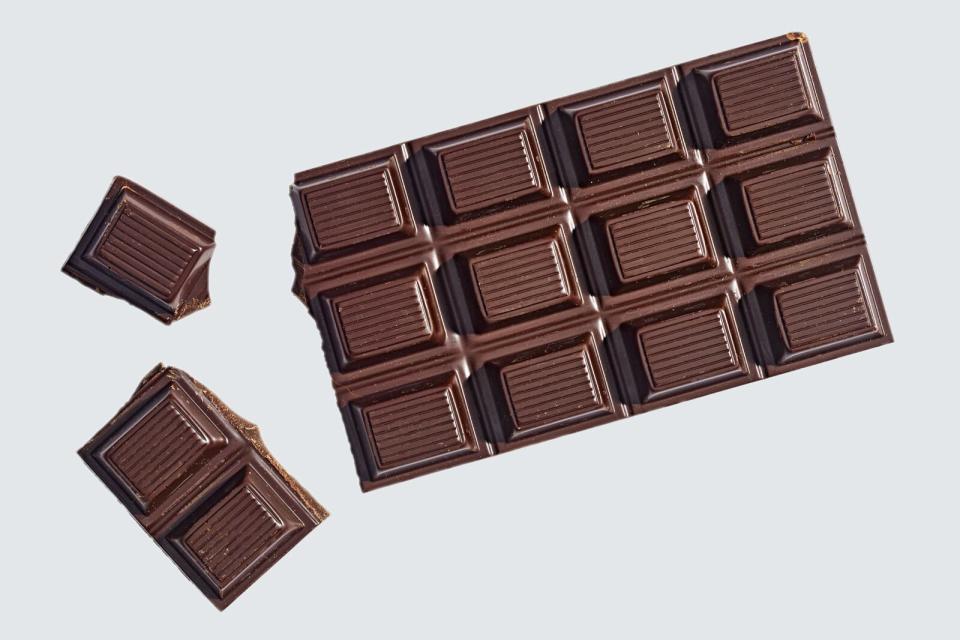The Best Way to Store Chocolate Is Not in the Refrigerator, According to Experts
TABLE OF CONTENTS
On This Page
Storing Chocolate
Sugar Bloom vs. Fat Bloom
Keep It Wrapped
Shelf Life
Storing Chocolate Confections
Whether you're saving some special chocolate bars for just the right moment or recently received a gift box of truffles and bonbons, proper storage is key to ensuring that when you do enjoy that chocolate, it tastes just as delicious as it should. While you may think that keeping chocolate in the refrigerator prevents it from melting, doing so may actually produce unwanted moisture on the bar. Instead, two chocolatiers offer an alternative way to store the sweet treat.

Chelsea Cavanaugh
Related: The Best and Easiest Ways to Freeze Cookies and Cookie Dough
The Best Way to Store Chocolate
In general, it's best to keep chocolate at room temperature, fully wrapped and away from heat and water. Carol Gancia, founder and head chocolatier of Kokak Chocolates in San Francisco, Calif., says that unless you have a humidity-controlled refrigerator meant for optimal chocolate storage, keeping chocolate in your refrigerator will introduce moisture to your chocolate bars, which isn't ideal.
If you do decide to store chocolate bars in the refrigerator (perhaps because it's especially warm in your house and you don't want it to melt), Kjartan Gíslason, chef and co-founder of Omnom Chocolate in Reykjavík, Iceland, recommends letting it sit at room temperature for at least 30 minutes so that it isn't too hard to bite into.
How Humidity and Heat Affects Chocolate
You'll know a chocolate bar has sugar or fat bloom if you open it up and find that there is a whitish coating on it.
Sugar Bloom
Sugar bloom occurs when chocolate is exposed to humidity for an extended period of time, and fat bloom occurs when chocolate is exposed to heat. "Moisture draws out sugar, and when it evaporates, white sugar crystals rise to the surface of your bar," Gancia says. "While it is safe to eat chocolate with sugar bloom, it's way more fun to enjoy a shiny, beautiful bar!"
Fat Bloom
"Fat blooming mostly occurs when chocolate has gone through some heat fluctuation during storage," Gíslason says. For example, on a hot day, chocolate can reach its melting point and later cool down, which can cause the cocoa fat to release from its tempered stage and seep to the surface. "This doesn't mean that your chocolate has gone bad," Gíslason says. "It will taste almost the same, but its appearance is definitely altered."
Keep It Wrapped
Chocolate absorbs scents easily, so keeping it wrapped and away from other things that may impact its flavor (like garlic, onions, and even your spice cabinet) is key. "If you have opened the packaging and want to store it afterwards, make sure to wrap it back nicely; oxygen can be the enemy and might bring unwanted odors to the flavor," Gíslason says.
Once Opened, Consume Quickly
Once you've started eating a chocolate bar, our experts agree that the sooner you finish it, the better. "Opened chocolate bars can pick up odor, melt, get water exposure, and get scratched up, taking away from the full experience of opening a shiny bar that smells and tastes as intended," Gancia says. "While a dark chocolate bar can keep for as long as two years, consuming it within a couple of weeks once opened will give you the best enjoyment of your chocolate."
The Best Way to Store Chocolate Confections
As for truffles, bonbons, and other chocolate confections, Gancia recommends storing them in a sealed container at room temperature: "Keep them in a cool, dry, dark place away from heat, moisture, and strong scents."
Gíslason adds that you should note the "best before" date if there is one indicated on the label, which typically ranges from a week to six months. "Generally, these dates are set because of a particular ingredient in the confectionery," he says. "For instance, fresh cream, nuts, and butter will go rancid pretty quickly, and those types of confection are meant to be eaten as soon as possible."

